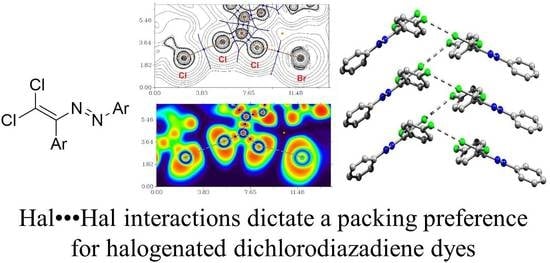Halogenated Diazabutadiene Dyes: Synthesis, Structures, Supramolecular Features, and Theoretical Studies
Abstract
:1. Introduction
2. Results and Discussion
3. Materials and Methods
3.1. Crystal Structure Determination
3.2. Synthetic Part
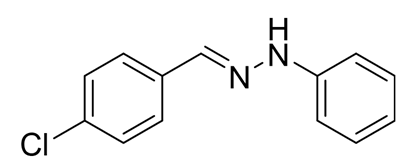 | 1. White solid (69%), mp 118 °C. 1H NMR (300 MHz, DMSO-d6) δ 10.46 (s, 1H, NH), 7.85 (s, 1H, CH), 7.66 (d, J = 8.4 Hz, 2H, arom), 7.43 (d, J = 8.4 Hz, 2H, arom), 7.23 (t, J = 7.7 Hz, 2H, arom), 7.09 (d, J = 7.9 Hz, 2H, arom), 6.76 (t, J = 7.2 Hz, 1H, arom). 13C NMR (75 MHz, DMSO-d6) δ 145.5, 135.4, 135.2, 132.5, 129.5, 129.1, 127.5, 119.41, 112.5. |
 | 2. White solid (92%), mp 151 °C. 1H NMR (300 MHz, DMSO-d6) δ 10.33 (s, 1H, NH), 7.80 (s, 1H, CH), 7.66 (s, 1H, arom), 7.42 (d, J = 8.4 Hz, 2H, arom), 7.00 (q, J = 8.4 Hz, 5H, arom), 2.09 (s, 3H, CH3). 13C NMR (75 MHz, DMSO-d6) δ 138.6, 130.8, 130.1, 127.7, 125.4, 124.5, 123.3, 122.8, 107.92, 16.1. |
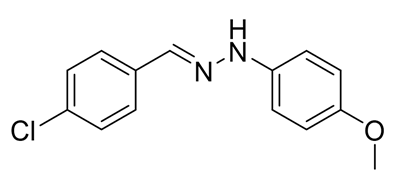 | 3. White solid (87%), mp 141 °C. 1H NMR (300 MHz, DMSO-d6) δ 10.24 (s, 1H, NH), 7.78 (s, 1H, CH), 7.63 (d, J = 8.5 Hz, 2H, arom), 7.41 (d, J = 8.5 Hz, 2H, arom), 7.01 (d, J = 8.9 Hz, 2H, arom), 6.84 (d, J = 8.9 Hz, 2H, arom), 3.69 (s, 3H, OCH3). 13C NMR (75 MHz, DMSO-d6) δ 153.2, 139.5, 135.5, 134.2, 132.1, 129.0, 127.3, 115.0, 113.5, 55.7. |
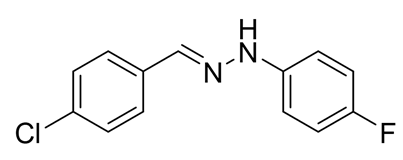 | 4. White solid (77%), mp 135 °C. 1H NMR (300 MHz, DMSO-d6) δ 7.02 (d, 2H, J = 6.0 Hz), 7.22 (t, 2H, J = 9.1 Hz), 7.37 (d, 2H, J = 9.1 Hz), 7.68–7.73(m, 2H), 7.87(s, 1H), 10.49 (s, 1H). 13C NMR (75 MHz, DMSO-d6) δ 114.3, 115.9, 116.2, 128.0, 132.1, 132,63, 136,7, 145.0, 109.9. |
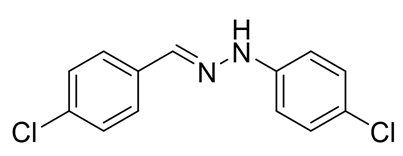 | 5. White solid (76%), mp 153 °C. 1H NMR (300 MHz, DMSO-d6) δ 10.58 (s, 1H, NH), 7.85 (s, 1H, CH), 7.67 (d, J = 8.3 Hz, 2H, arom), 7.48–7.38 (m, 2H, arom), 7.25 (d, J = 8.7 Hz, 2H, arom), 7.07 (d, J = 8.7 Hz, 2H, arom). 13C NMR (75 MHz, DMSO-d6) δ 144.4, 136.3, 135.0, 132.8, 129.3, 129.1, 127.7, 122.6, 113.9. |
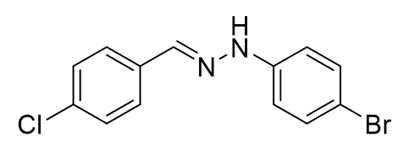 | 6. White solid (94%), mp 131 °C. 1H NMR (300 MHz, DMSO-d6) δ 10.59 (s, 1H, NH), 7.85 (s, 1H, CH), 7.67 (d, J = 8.5 Hz, 2H, arom), 7.43 (d, J = 8.5 Hz, 2H, arom), 7.37 (d, J = 8.8 Hz, 2H, arom), 7.03 (d, J = 8.8 Hz, 2H, arom). 13C NMR (75 MHz, DMSO-d6) δ 144.8, 136.4, 134.9, 132.8, 132.2, 129.1, 127.7, 114.4, 110.2, 39.9. |
 | 7. White solid (72%), mp 119 °C. 1H NMR (300 MHz, DMSO-d6) δ 10.30 (s, 1H, NH), 7.81 (s, 1H, CH), 7.65 (d, J = 8.5 Hz, 2H, arom), 7.42 (d, J = 8.5 Hz, 2H, arom), 6.69 (s, 2H, arom), 6.41 (s, 1H, arom), 2.22 (s, 6H, CH3). 13C NMR (75 MHz, DMSO-d6) δ 145.3, 138.5, 135.3, 135.0, 132.3, 129.1, 127.5, 121.3, 110.3, 21.7. |
 | 8. White solid (88%), mp 114 °C. 1H NMR (300 MHz, DMSO-d6) δ 10.16 (s, 1H, NH), 8.28 (s, 1H, CH), 7.69 (d, J = 8.7 Hz, 2H, arom), 7.56 (d, J = 8.7 Hz, 1H, arom), 7.51–7.43 (m, 3H, arom), 7.35–7.17 (m, 1H, arom). 13C NMR (75 MHz, DMSO-d6) δ 162.3, 140.9, 140.1, 134.6, 133.4, 129.2, 129.0, 128.5, 128.1, 122.8, 117.1, 115.5. |
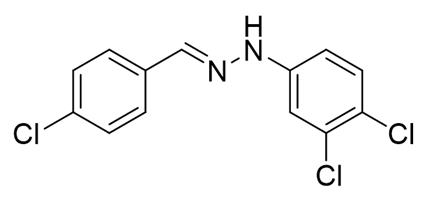 | 9. White solid (92%), mp 112 °C. 1H NMR (300 MHz, DMSO-d6) δ 10.74 (s, 1H, NH), 7.90 (d, J = 14.3 Hz, 1H), 7.69 (d, J = 8.3 Hz, 2H, arom), 7.44 (q, J = 8.3, 7.5 Hz, 3H, arom), 7.26 (s, 1H, CH), 7.00 (d, J = 8.4 Hz, 1H, arom). 13C NMR (75 MHz, DMSO-d6) δ 145.6, 137.6, 134.6, 133.2, 132.1, 131.5, 131.3, 130.2, 129.8, 129.1, 128.0, 120.1, 113.3, 112.8. |
3.3. Synthesis of Dichlorodiazadiens
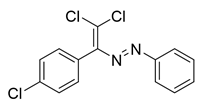 | 10. Red solid (73%), mp 85 °C. 1H NMR (300 MHz, CDCl3) δ 7.71–7.60 (m, 2H, arom), 7.35 (dd, J = 7.6, 3.8 Hz, 4H, arom), 7.28 (s, 1H, arom), 7.03 (d, J = 8.3 Hz, 2H, arom). 13C NMR (75 MHz, CDCl3) δ 134.6, 131.7, 131.3, 130.7, 129.4, 129.0, 128.4, 127.1, 126.2, 123.1. |
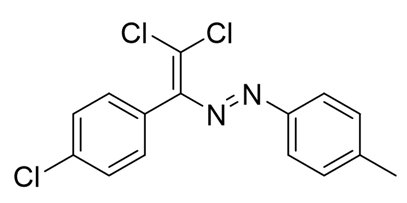 | 11. Red solid (79%), mp 90 °C. 1H NMR (300 MHz, CDCl3) δ 7.69 (d, J = 8.2 Hz, 2H, arom), 7.42 (d, J = 8.3 Hz, 2H, arom), 7.26 (d, J = 8.2 Hz, 2H, arom), 7.13 (d, J = 8.3 Hz, 2H, arom), 2.42 (s, 3H, CH3). 13C NMR (75 MHz, CDCl3) δ 162.3, 151.2, 150.9, 142.5, 134.7, 131.4, 131.0, 129.7, 128.4, 123.2, 21.5. Crystals, suitable for X-ray analysis, were obtained by the slow evaporation of saturated hexane/EtOAc (5/1) solution. |
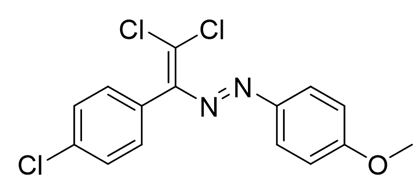 | 12. Red solid (72%), mp 96 °C. 1H NMR (300 MHz, CDCl3) δ 7.78 (d, J = 9.0 Hz, 2H, arom), 7.42 (d, J = 8.4 Hz, 2H, arom), 7.13 (d, J = 8.4 Hz, 2H, arom), 6.95 (d, J = 9.0 Hz, 2H, arom), 3.88 (s, 3H, OCH3). 13C NMR (75 MHz, CDCl3) δ 162.7, 162.3, 151.1, 147.2, 134.6, 131.4, 131.2, 128.4, 125.3, 114.2, 55.6. |
 | 13. Red solid (68%), mp 77 °C. 1H NMR (300 MHz, CDCl3) δ 7.81 (dd, J = 8.6, 5.4 Hz, 2H), 7.43 (d, J = 8.3 Hz, 2H), 7.14 (t, J = 8.8 Hz, 4H). 13C NMR (75 MHz, CDCl3) δ 167.6, 166.4, 151.1, 149.3, 134.8, 131.4, 130.8, 129.6, 128.5, 125.4, 116.2, 115.9. Crystals, suitable for X-ray analysis, were obtained by the slow evaporation of saturated hexane/EtOAc (5/1) solution. |
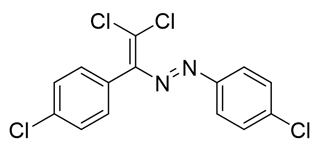 | 14. Red solid (67%), mp 94 °C. 1H NMR (300 MHz, CDCl3) δ 7.73 (d, J = 8.6 Hz, 1H), 7.43 (d, J = 8.4 Hz, 2H), 7.12 (d, J = 8.4 Hz, 1H). 13C NMR (75 MHz, CDCl3) δ 162.3, 151.1, 137.7, 136.5, 134.9, 131.4, 130.6, 129.3, 128.5, 124.4. Crystals, suitable for X-ray analysis, were obtained by the slow evaporation of saturated hexane/EtOAc (5/1) solution. |
 | 15. Red solid (70%), mp 105 °C. 1H NMR (300 MHz, CDCl3) δ 7.69–7.56 (m, 4H, arom), 7.49–7.39 (m, 2H, arom), 7.12 (d, J = 8.4 Hz, 2H, arom). 13C NMR (75 MHz, CDCl3) δ 151.4, 134.9, 132.3, 131.4, 130.6, 129.8, 128.5, 127.4, 126.3, 124.6. Crystals, suitable for X-ray analysis, were obtained by the slow evaporation of saturated hexane/EtOAc (5/1) solution. |
 | 16. Red solid (82%), mp 145 °C. 1H NMR (300 MHz, CDCl3) δ 7.44 (d, J = 7.7 Hz, 4H, arom), 7.15 (d, J = 7.7 Hz, 3H, arom), 2.40 (s, 6H, CH3). 13C NMR (75 MHz, CDCl3) δ 157.7, 148.3, 146.7, 134.2, 130.2, 129.0, 126.8, 126.5, 123.9, 116.5, 16.6. |
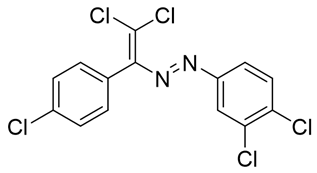 | 17. Red solid (66%), mp 115 °C. 1H NMR (300 MHz, CDCl3) δ 7.89 (s, 1H, arom), 7.68–7.61 (m, 1H, arom), 7.54 (d, J = 8.6 Hz, 1H, arom), 7.44 (d, J = 8.3 Hz, 2H, arom), 7.11 (d, J = 8.3 Hz, 2H, arom). 13C NMR (75 MHz, CDCl3) δ 151.5, 151.4, 135.7, 135.0, 133.5, 131.3, 130.8, 130.4, 129.8, 128.6, 124.5, 122.7. Crystals, suitable for X-ray analysis, were obtained by the slow evaporation of saturated hexane/EtOAc (5/1) solution. |
 | 18. Red solid (71%), mp 121 °C. 1H NMR (300 MHz, CDCl3) δ 7.57 (d, J = 8.7 Hz, 1H, arom), 7.46 (d, J = 2.0 Hz, 1H, arom), 7.37 (d, J = 8.4 Hz, 2H, arom), 7.24 (d, J = 2.3 Hz, 1H, arom), 7.12 (d, J = 8.4 Hz, 2H, arom). |
4. Conclusions
Supplementary Materials
Author Contributions
Funding
Conflicts of Interest
References
- Bertani, R.; Sgarbossa, P.; Venzo, A.; Lelj, F.; Amati, M.; Resnati, G.; Pilati, T.; Metrangolo, P.; Terraneo, G. Halogen bonding in metal-organic-supramolecular networks. Coord. Chem. Rev. 2010, 254, 677–695. [Google Scholar] [CrossRef]
- Adonin, S.A.; Gorokh, I.D.; Samsonenko, D.G.; Novikov, A.S.; Korolkov, I.V.; Plyusnin, P.E.; Sokolov, M.N.; Fedin, V.P. Binuclear and polymeric bromobismuthate complexes: Crystal structures and thermal stability. Polyhedron 2019, 159, 318–322. [Google Scholar] [CrossRef]
- Adonin, S.A.; Bondarenko, M.A.; Abramov, P.A.; Novikov, A.S.; Plyusnin, P.E.; Sokolov, M.N.; Fedin, V.P. Bromo- and Polybromoantimonates(V): Structural and Theoretical Studies of Hybrid Halogen-Rich Halometalate Frameworks. Chem.-A Eur. J. 2018, 24, 10165–10170. [Google Scholar] [CrossRef]
- Saha, A.; Rather, S.A.; Sharada, D.; Saha, B.K. C-X···X-C vs C-H···X-C, which one is the more dominant interaction in crystal packing (X = halogen)? Cryst. Growth Des. 2018, 18, 6084–6090. [Google Scholar] [CrossRef]
- Usoltsev, A.N.; Adonin, S.A.; Novikov, A.S.; Samsonenko, D.G.; Sokolov, M.N.; Fedin, V.P. One-dimensional polymeric polybromotellurates(IV): Structural and theoretical insights into halogen⋯halogen contacts. CrystEngComm 2017, 19, 5934–5939. [Google Scholar] [CrossRef]
- Adonin, S.A.; Gorokh, I.D.; Novikov, A.S.; Abramov, P.A.; Sokolov, M.N.; Fedin, V.P. Halogen Contacts-Induced Unusual Coloring in BiIII Bromide Complex: Anion-to-Cation Charge Transfer via Br⋅⋅⋅Br Interactions. Chem.-A Eur. J. 2017, 23, 15612–15616. [Google Scholar] [CrossRef]
- Nguyen, H.L.; Horton, P.N.; Hursthouse, M.B.; Legon, A.C.; Bruce, D.W. Halogen Bonding: A New Interaction for Liquid Crystal Formation. J. Am. Chem. Soc. 2004, 126, 16–17. [Google Scholar] [CrossRef] [PubMed]
- Cariati, E.; Cavallo, G.; Forni, A.; Leem, G.; Metrangolo, P.; Meyer, F.; Pilati, T.; Resnati, G.; Righetto, S.; Terraneo, G.; et al. Self-complementary nonlinear optical-phores targeted to halogen bond-driven self-assembly of electro-optic materials. Cryst. Growth Des. 2011, 11, 5642–5648. [Google Scholar] [CrossRef]
- Sun, A.; Lauher, J.W.; Goroff, N.S. Preparation of poly(diiododiacetylene), an ordered conjugated polymer of carbon and iodine. Science 2006, 312, 1030–1034. [Google Scholar] [CrossRef] [Green Version]
- Metrangolo, P.; Resnati, G. Halogen Versus Hydrogen. Science 2008, 321, 918–919. [Google Scholar] [CrossRef]
- Yang, L.; Tan, X.; Wang, Z.; Zhang, X. Supramolecular Polymers: Historical Development, Preparation, Characterization, and Functions. Chem. Rev. 2015, 115, 7196–7239. [Google Scholar] [CrossRef]
- Maharramov, A.M.; Mahmudov, K.T.; Kopylovich, M.N.; Pombeiro, A.J.L. Non-covalent Interactions in the Synthesis and Design of New Compounds; John Wiley & Sons Limited: Hoboken, NJ, USA, 2016; ISBN 9781119113874. [Google Scholar]
- Berger, G.; Frangville, P.; Meyer, F. Halogen bonding for molecular recognition: New developments in materials and biological sciences. Chem. Commun. 2020, 56, 4970–4981. [Google Scholar] [CrossRef] [PubMed]
- Mahadevi, A.S.; Sastry, G.N. Cooperativity in Noncovalent Interactions. Chem. Rev. 2016, 116, 2775–2825. [Google Scholar] [CrossRef] [PubMed]
- Walsh, R.B.; Padgett, C.W.; Metrangolo, P.; Resnati, G.; Hanks, T.W.; Pennington, W.T. Crystal Engineering through Halogen Bonding: Complexes of Nitrogen Heterocycles with Organic Iodides. Cryst. Growth Des. 2001, 1, 165–175. [Google Scholar] [CrossRef]
- Teyssandier, J.; Mali, K.S.; De Feyter, S. Halogen Bonding in Two-Dimensional Crystal Engineering. ChemistryOpen 2020, 9, 225–241. [Google Scholar] [CrossRef]
- Berger, G.; Soubhye, J.; Meyer, F. Halogen bonding in polymer science: From crystal engineering to functional supramolecular polymers and materials. Polym. Chem. 2015, 6, 3559–3580. [Google Scholar] [CrossRef]
- Saha, B.K.; Rather, S.A.; Saha, A. Interhalogen Interactions in the Light of Geometrical Correction. Cryst. Growth Des. 2016, 16, 3059–3062. [Google Scholar] [CrossRef]
- Bui, T.T.T.; Dahaoui, S.; Lecomte, C.; Desiraju, G.R.; Espinosa, E. The nature of halogen halogen interactions: A model derived from experimental charge-density analysis. Angew. Chemie-Int. Ed. 2009, 48, 3838–3841. [Google Scholar] [CrossRef]
- Yang, H.; Wong, M.W. Application of halogen bonding to organocatalysis: A theoretical perspective. Molecules 2020, 25, 1045. [Google Scholar] [CrossRef] [Green Version]
- Kolář, M.H.; Hobza, P. Computer Modeling of Halogen Bonds and Other σ-Hole Interactions. Chem. Rev. 2016, 116, 5155–5187. [Google Scholar] [CrossRef] [Green Version]
- Priimagi, A.; Cavallo, G.; Forni, A.; Gorynsztejn-Leben, M.; Kaivola, M.; Metrangolo, P.; Milani, R.; Shishido, A.; Pilati, T.; Resnati, G.; et al. Halogen bonding versus hydrogen bonding in driving self-assembly and performance of light-responsive supramolecular polymers. Adv. Funct. Mater. 2012, 22, 2572–2579. [Google Scholar] [CrossRef] [Green Version]
- Cavallo, G.; Metrangolo, P.; Milani, R.; Pilati, T.; Priimagi, A.; Resnati, G.; Terraneo, G. The Halogen Bond. Chem. Rev. 2016, 116, 2478–2601. [Google Scholar] [CrossRef] [Green Version]
- Nenajdenko, V.G.; Shastin, A.V.; Gorbachev, V.M.; Shorunov, S.V.; Muzalevskiy, V.M.; Lukianova, A.I.; Dorovatovskii, P.V.; Khrustalev, V.N. Copper-Catalyzed Transformation of Hydrazones into Halogenated Azabutadienes, Versatile Building Blocks for Organic Synthesis. ACS Catal. 2017, 7, 205–209. [Google Scholar] [CrossRef]
- Shastin, A.V.; Sergeev, P.G.; Lukianova, A.I.; Muzalevskiy, V.M.; Khrustalev, V.N.; Dorovatovskii, P.V.; Nenajdenko, V.G. Dichloro-Substituted 1,2-Diazabuta-1,3-dienes as Highly Reactive Electrophiles in the Reaction with Amines and Diamines: Efficient Synthesis of α-Hydrazo Amidinium Salts. European J. Org. Chem. 2018, 2018, 4996–5006. [Google Scholar] [CrossRef]
- Shastin, A.V.; Tsyrenova, B.D.; Sergeev, P.G.; Roznyatovsky, V.A.; Smolyar, I.V.; Khrustalev, V.N.; Nenajdenko, V.G. Synthesis of a New Family of 1,1-Diazidoethenes: One-Pot Construction of 4-Azido-1,2,3-triazoles via Nitrene Cyclization. Org. Lett. 2018, 20, 7803–7806. [Google Scholar] [CrossRef]
- Tsyrenova, B.; Nenajdenko, V. Synthesis and spectral study of a new family of 2,5-diaryltriazoles having restricted rotation of the 5-aryl substituent. Molecules 2020, 25, 480. [Google Scholar] [CrossRef] [Green Version]
- Sergeev, P.G.; Khrustalev, V.N.; Nenajdenko, V.G. Construction of 6-Aminopyridazine Derivatives by the Reaction of Malononitrile with Dichloro-Substituted Diazadienes. European J. Org. Chem. 2020, 2020, 4964–4971. [Google Scholar] [CrossRef]
- Shikhaliyev, N.Q.; Kuznetsov, M.L.; Maharramov, A.M.; Gurbanov, A.V.; Ahmadova, N.E.; Nenajdenko, V.G.; Mahmudov, K.T.; Pombeiro, A.J.L. Noncovalent interactions in the design of bis-azo dyes. CrystEngComm 2019, 21, 5032–5038. [Google Scholar] [CrossRef]
- Shikhaliyev, N.Q.; Ahmadova, N.E.; Gurbanov, A.V.; Maharramov, A.M.; Mammadova, G.Z.; Nenajdenko, V.G.; Zubkov, F.I.; Mahmudov, K.T.; Pombeiro, A.J.L. Tetrel, halogen and hydrogen bonds in bis(4-((E)-(2,2-dichloro-1-(4-substitutedphenyl)vinyl)diazenyl)phenyl)methane dyes. Dye. Pigment. 2018, 150, 377–381. [Google Scholar] [CrossRef]
- Maharramov, A.M.; Shikhaliyev, N.Q.; Suleymanova, G.T.; Gurbanov, A.V.; Babayeva, G.V.; Mammadova, G.Z.; Zubkov, F.I.; Nenajdenko, V.G.; Mahmudov, K.T.; Pombeiro, A.J.L. Pnicogen, halogen and hydrogen bonds in (E)-1-(2,2-dichloro-1-(2-nitrophenyl)vinyl)-2-(para-substituted phenyl)-diazenes. Dye. Pigment. 2018, 159, 135–141. [Google Scholar] [CrossRef]
- Repina, O.V.; Novikov, A.S.; Khoroshilova, O.V.; Kritchenkov, A.S.; Vasin, A.A.; Tskhovrebov, A.G. Lasagna-like supramolecular polymers derived from the PdII osazone complexes via C(sp2)–H⋯Hal hydrogen bonding. Inorganica Chim. Acta 2020, 502, 119378. [Google Scholar] [CrossRef]
- Tskhovrebov, A.G.; Novikov, A.S.; Odintsova, O.V.; Mikhaylov, V.N.; Sorokoumov, V.N.; Serebryanskaya, T.V.; Starova, G.L. Supramolecular polymers derived from the PtII and PdII schiff base complexes via C(sp2)–H … Hal hydrogen bonding: Combined experimental and theoretical study. J. Organomet. Chem. 2019, 886, 71–75. [Google Scholar] [CrossRef]
- Tskhovrebov, A.G.; Vasileva, A.A.; Goddard, R.; Riedel, T.; Dyson, P.J.; Mikhaylov, V.N.; Serebryanskaya, T.V.; Sorokoumov, V.N.; Haukka, M. Palladium(II)-Stabilized Pyridine-2-Diazotates: Synthesis, Structural Characterization, and Cytotoxicity Studies. Inorg. Chem. 2018, 57, 930–934. [Google Scholar] [CrossRef]
- Mikhaylov, V.N.; Sorokoumov, V.N.; Liakhov, D.M.; Tskhovrebov, A.G.; Balova, I.A. Polystyrene-supported acyclic diaminocarbene palladium complexes in Sonogashira cross-coupling: Stability vs. catalytic activity. Catalysts 2018, 8, 141. [Google Scholar] [CrossRef] [Green Version]
- Tskhovrebov, A.G.; Luzyanin, K.V.; Kuznetsov, M.L.; Sorokoumov, V.N.; Balova, I.A.; Haukka, M.; Kukushkin, V.Y. Substituent R-dependent regioselectivity switch in nucleophilic addition of N-phenylbenzamidine to PdII-and PtII-complexed isonitrile RN-C giving aminocarbene-like species. Organometallics 2011, 30, 863–874. [Google Scholar] [CrossRef]
- Mikhaylov, V.N.; Sorokoumov, V.N.; Novikov, A.S.; Melnik, M.V.; Tskhovrebov, A.G.; Balova, I.A. Intramolecular hydrogen bonding stabilizes trans-configuration in a mixed carbene/isocyanide PdII complexes. J. Organomet. Chem. 2020, 912, 121174. [Google Scholar] [CrossRef]
- Tskhovrebov, A.G.; Luzyanin, K.V.; Haukka, M.; Kukushkin, V.Y. Synthesis and characterization of cis-(RNC)2PtII species useful as synthons for generation of various (aminocarbene)Pt II complexes. J. Chem. Crystallogr. 2012, 42, 1170–1175. [Google Scholar] [CrossRef]
- Tskhovrebov, A.G.; Novikov, A.S.; Kritchenkov, A.S.; Khrustalev, V.N.; Haukka, M. Attractive halogen···halogen interactions in crystal structure of trans-dibromogold(III) complex. Zeitschrift Krist. Cryst. Mater. 2020. [Google Scholar] [CrossRef]
- Bondi, A. Van der Waals volumes and radii of metals in covalent compounds. J. Phys. Chem. 1966, 70, 3006–3007. [Google Scholar] [CrossRef]
- Bader, R.F.W. A Quantum Theory of Molecular Structure and Its Applications. Chem. Rev. 1991, 91, 893–928. [Google Scholar] [CrossRef]
- Bartashevich, E.V.; Tsirelson, V.G. Interplay between non-covalent interactions in complexes and crystals with halogen bonds. Russ. Chem. Rev. 2014, 83, 1181–1203. [Google Scholar] [CrossRef]
- Adonin, S.A.; Gorokh, I.D.; Novikov, A.S.; Samsonenko, D.G.; Yushina, I.V.; Sokolov, M.N.; Fedin, V.P. Halobismuthates with halopyridinium cations: Appearance or non-appearance of unusual colouring. CrystEngComm 2018, 20, 7766–7772. [Google Scholar] [CrossRef]
- Espinosa, E.; Alkorta, I.; Elguero, J.; Molins, E. From weak to strong interactions: A comprehensive analysis of the topological and energetic properties of the electron density distribution involving X-H⋯F-Y systems. J. Chem. Phys. 2002, 117, 5529–5542. [Google Scholar] [CrossRef]
- Johnson, E.R.; Keinan, S.; Mori-Sánchez, P.; Contreras-García, J.; Cohen, A.J.; Yang, W. Revealing noncovalent interactions. J. Am. Chem. Soc. 2010, 132, 6498–6506. [Google Scholar] [CrossRef] [PubMed] [Green Version]
- Contreras-García, J.; Johnson, E.R.; Keinan, S.; Chaudret, R.; Piquemal, J.-P.; Beratan, D.N.; Yang, W. NCIPLOT: A Program for Plotting Noncovalent Interaction Regions. J. Chem. Theory Comput. 2011, 7, 625–632. [Google Scholar] [CrossRef] [PubMed]
- Chai, J.-D.; Head-Gordon, M. Long-range corrected hybrid density functionals with damped atom–atom dispersion corrections. Phys. Chem. Chem. Phys. 2008, 10, 6615–6620. [Google Scholar] [CrossRef] [Green Version]
- Curtiss, L.A.; McGrath, M.P.; Blaudeau, J.; Davis, N.E.; Binning, R.C.; Radom, L. Extension of Gaussian-2 theory to molecules containing third-row atoms Ga–Kr. J. Chem. Phys. 1995, 103, 6104–6113. [Google Scholar] [CrossRef]
- Francl, M.M.; Pietro, W.J.; Hehre, W.J.; Binkley, J.S.; Gordon, M.S.; DeFrees, D.J.; Pople, J.A. Self-consistent molecular orbital methods. XXIII. A polarization-type basis set for second-row elements. J. Chem. Phys. 1982, 77, 3654–3665. [Google Scholar] [CrossRef] [Green Version]
- Krishnan, R.; Binkley, J.S.; Seeger, R.; Pople, J.A. Self-consistent molecular orbital methods. XX. A basis set for correlated wave functions. J. Chem. Phys. 1980, 72, 650–654. [Google Scholar] [CrossRef]
- McLean, A.D.; Chandler, G.S. Contracted Gaussian basis sets for molecular calculations. I. Second row atoms, Z=11–18. J. Chem. Phys. 1980, 72, 5639–5648. [Google Scholar] [CrossRef]
- Lu, T.; Chen, F. Multiwfn: A multifunctional wavefunction analyzer. J. Comput. Chem. 2012, 33, 580–592. [Google Scholar] [CrossRef]
- Spackman, M.A.; Jayatilaka, D. Hirshfeld surface analysis. CrystEngComm 2009, 11, 19–32. [Google Scholar] [CrossRef]
- McKinnon, J.J.; Jayatilaka, D.; Spackman, M.A. Towards quantitative analysis of intermolecular interactions with Hirshfeld surfaces. Chem. Commun. 2007, 3814–3816. [Google Scholar] [CrossRef] [PubMed]
- Evans, P. Scaling and assessment of data quality. Acta Crystallogr. Sect. D Biol. Crystallogr. 2006, 62, 72–82. [Google Scholar] [CrossRef]
- Battye, T.G.G.; Kontogiannis, L.; Johnson, O.; Powell, H.R.; Leslie, A.G.W. iMOSFLM: A new graphical interface for diffraction-image processing with MOSFLM. Acta Crystallogr. Sect. D Biol. Crystallogr. 2011, 67, 271–281. [Google Scholar] [CrossRef] [PubMed] [Green Version]
- Winn, M.D.; Ballard, C.C.; Cowtan, K.D.; Dodson, E.J.; Emsley, P.; Evans, P.R.; Keegan, R.M.; Krissinel, E.B.; Leslie, A.G.W.; McCoy, A.; et al. Overview of the CCP4 suite and current developments. Acta Crystallogr. Sect. D Biol. Crystallogr. 2011, 67, 235–242. [Google Scholar] [CrossRef] [Green Version]
- Sheldrick, G.M. SHELXT—Integrated space-group and crystal-structure determination. Acta Crystallogr. Sect. A Found. Crystallogr. 2015, 71, 3–8. [Google Scholar] [CrossRef] [Green Version]
- Sheldrick, G.M. A short history of SHELX. Acta Crystallogr. A 2008, 64, 112–122. [Google Scholar] [CrossRef] [Green Version]
- Sheldrick, G.M. Crystal structure refinement with SHELXL. Acta Crystallogr. Sect. C Struct. Chem. 2015, 71, 3–8. [Google Scholar] [CrossRef]

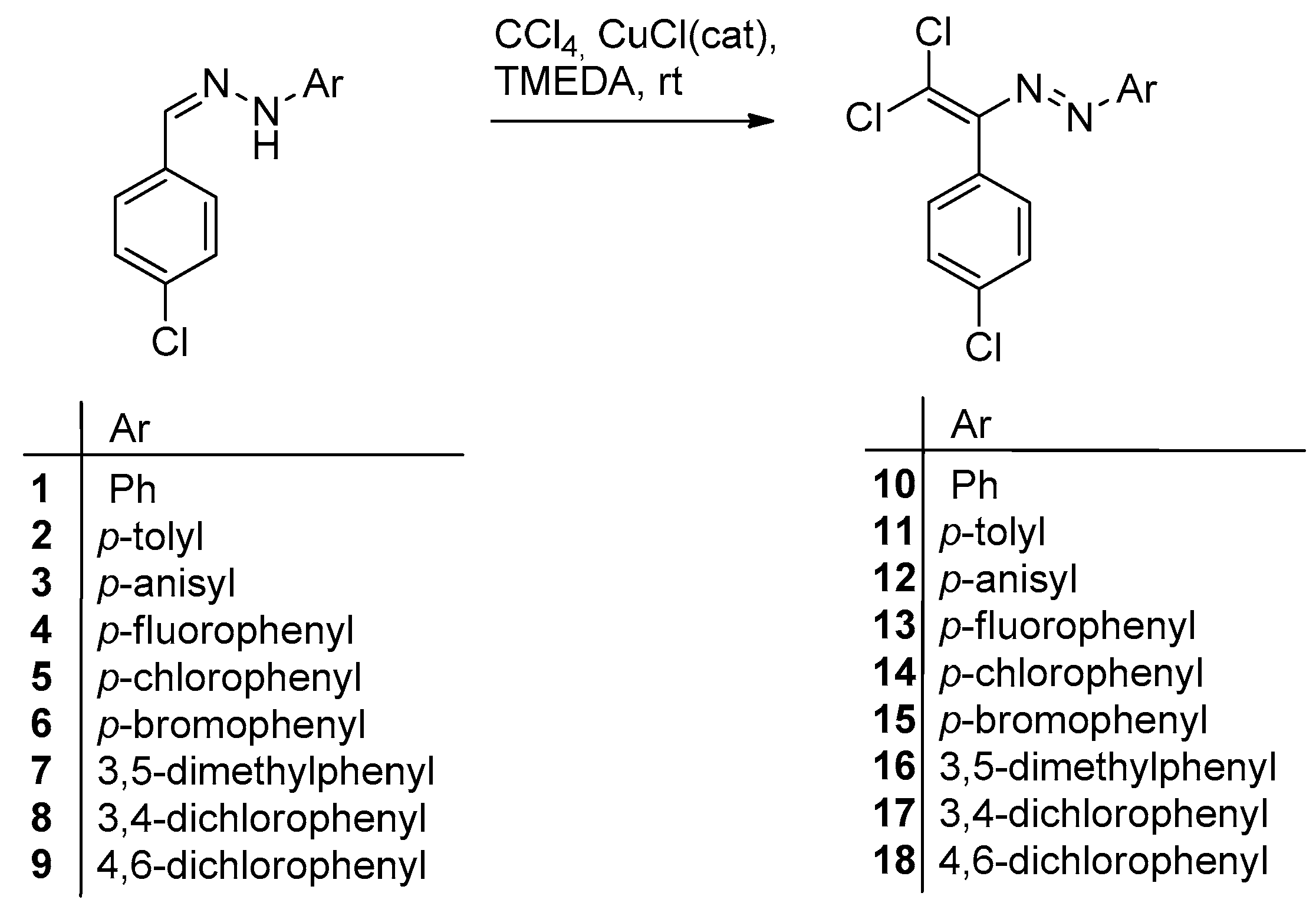



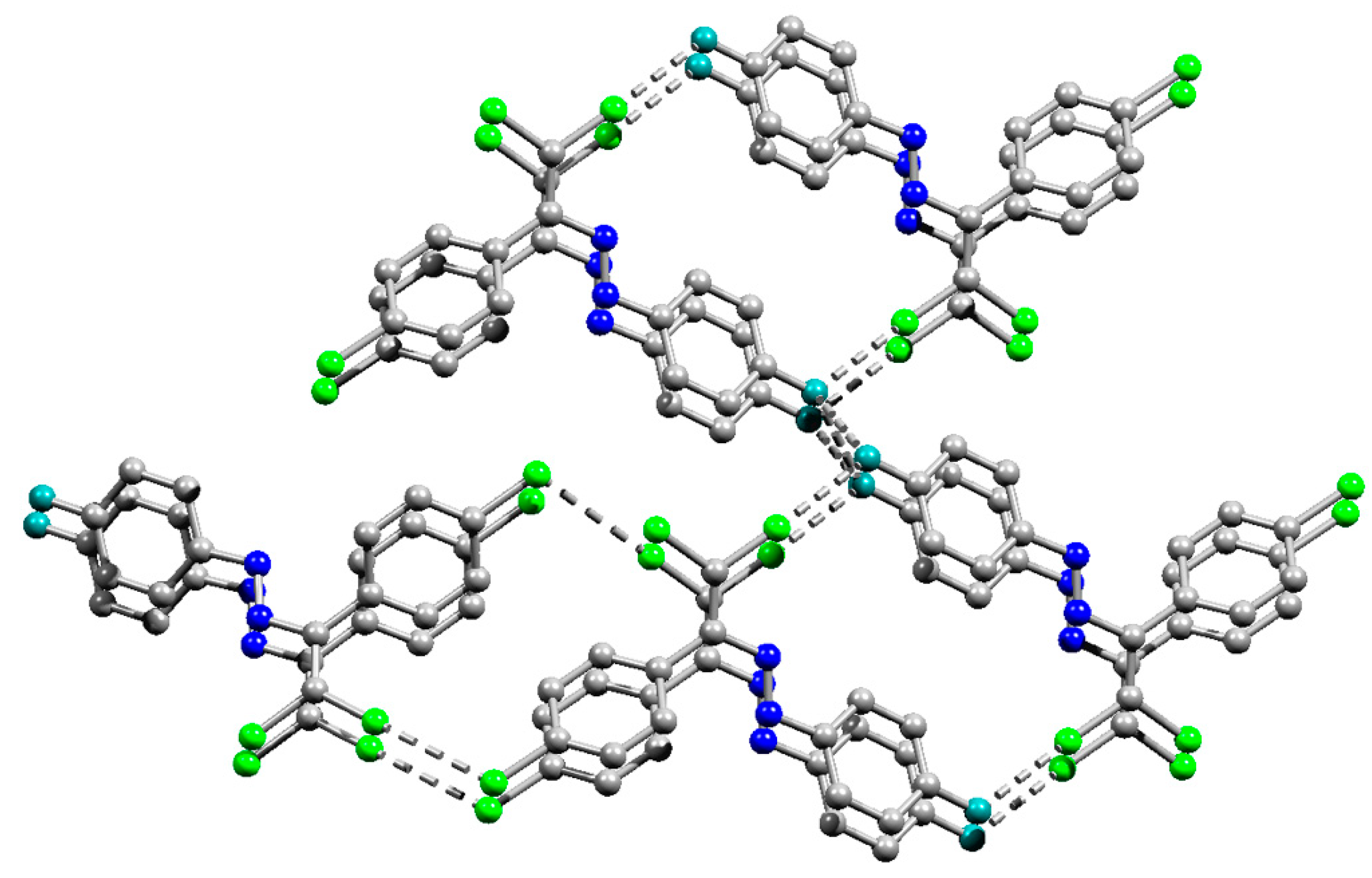

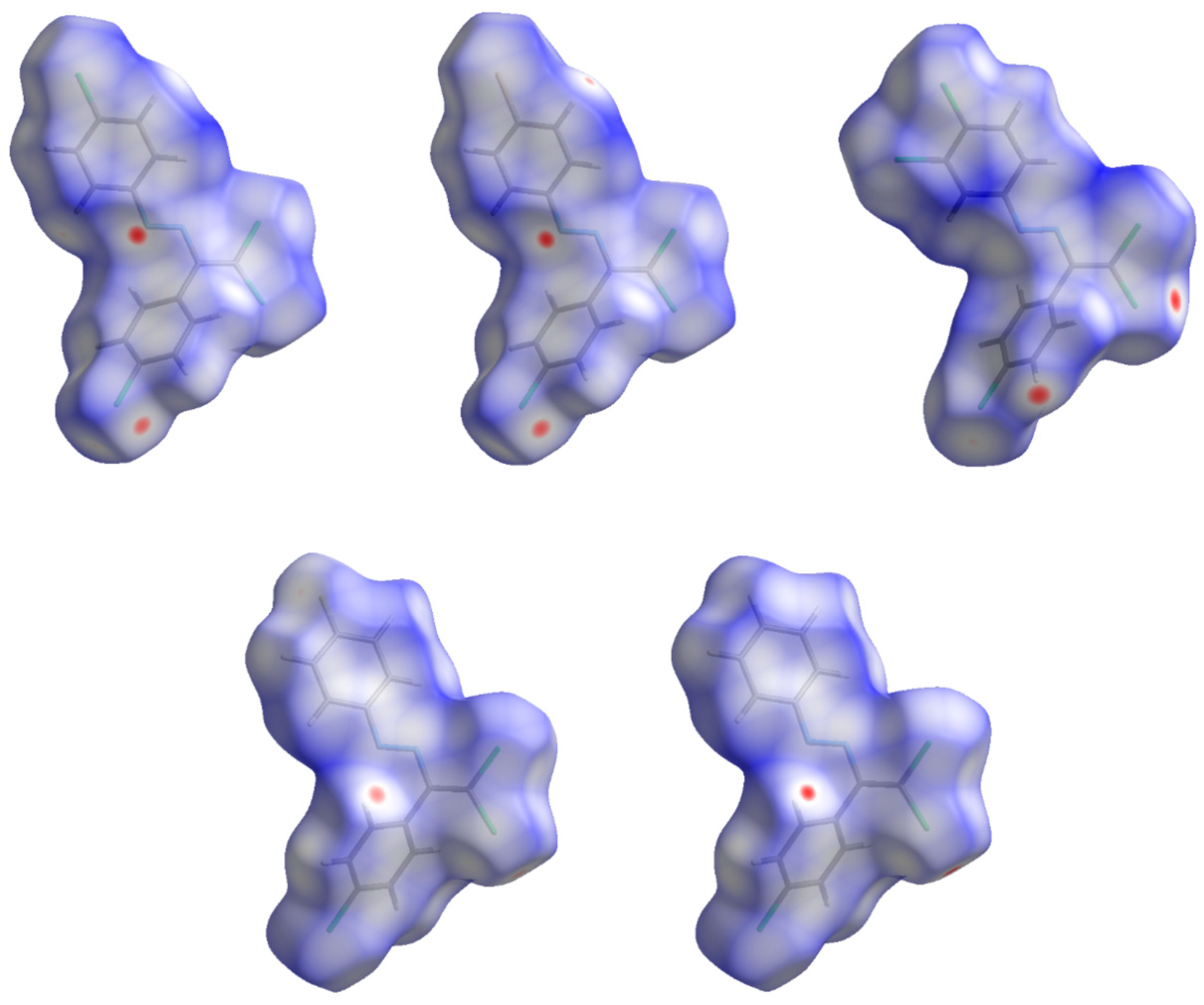
| Halogen–Halogen Contact | ρ(r) | ∇2ρ(r) | λ2 | Hb | V(r) | G(r) | Eint a | Eint b |
|---|---|---|---|---|---|---|---|---|
| 10 Cl···Cl, 3.377 Å (96% from the sum of Bondi’s vdW radii) | 0.008 | 0.031 | −0.012 | 0.002 | −0.004 | 0.006 | 1.2 | 1.8 |
| 13 F···F, 2.864 Å (97% from the sum of Bondi’s vdW radii) | 0.006 | 0.031 | −0.007 | 0.001 | −0.006 | 0.007 | ≈2 * | ≈2 * |
| 13 F···F, 2.917 Å (99% from the sum of Bondi’s vdW radii) | 0.007 | 0.031 | −0.008 | 0.001 | −0.006 | 0.007 | ≈2 * | ≈2 * |
| 13 Cl···F, 2.963 Å (92% from the sum of Bondi’s vdW radii) | 0.009 | 0.042 | −0.013 | 0.001 | −0.008 | 0.009 | 2.5 | 2.7 |
| 13 Cl···Cl, 3.405 Å (97% from the sum of Bondi’s vdW radii) | 0.007 | 0.029 | −0.011 | 0.002 | −0.004 | 0.006 | 1.2 | 1.8 |
| 14 Cl···Cl, 3.463 Å (99% from the sum of Bondi’s vdW radii) | 0.007 | 0.026 | −0.009 | 0.002 | −0.003 | 0.005 | 0.9 | 1.5 |
| 14 Cl···Cl, 3.399 Å (97% from the sum of Bondi’s vdW radii) | 0.007 | 0.029 | −0.011 | 0.002 | −0.004 | 0.006 | 1.2 | 1.8 |
| 15 Cl···Br, 3.637 Å (102% from the sum of Bondi’s vdW radii) | 0.006 | 0.021 | −0.008 | 0.001 | −0.003 | 0.004 | 0.9 | 1.2 |
| 15 Cl···Cl, 3.394 Å (97% from the sum of Bondi’s vdW radii) | 0.007 | 0.030 | −0.011 | 0.002 | −0.004 | 0.006 | 1.2 | 1.8 |
| 17 Cl···Cl, 3.469 Å (99% from the sum of Bondi’s vdW radii) | 0.007 | 0.027 | −0.009 | 0.002 | −0.004 | 0.005 | 1.2 | 1.5 |
| X-Ray Structure | Contributions of Different Interatomic Contacts to the Hirshfeld Surfaces |
|---|---|
| 10 | Cl-H 37.4%, H-H 21.0%, C-H 15.8%, C-C 7.9%, Cl-Cl 5.9%, N-H 5.8%, N-C 3.0%, -Cl-C 2.9%, Cl-N 0.1% |
| 13 | Cl-H 32.6%, H-H 16.2%, C-H 14.6%, C-C 7.4%, Cl-Cl 6.1%, N-H 5.8%, Cl-F 4.1%, N-C 3.1%, Cl-C 3.0%, F-H 2.8%, F-F 2.5%, F-C 1.7% |
| 14 | Cl-H 33.5%, H-H 17.1%, Cl-Cl 15.7%, C-H 12.6%, C-C 8.5%, N-H 5.2%, Cl-C 4.1%, N-C 3.2%, N-N 0.1% |
| 15 | Cl-H 30.7%, H-H 15.7%, C-H 13.0%, C-C 8.1%, Cl-Cl 5.8%, Br-Cl 5.7%, N-H 5.2%, Br-H 4.6%, Br-Br 3.8%, N-C 3.2%, Cl-C 2.2%, Br-C 1.8%, N-N 0.1% |
| 17 | Cl-H 44.6%, Cl-C 15.6%, H-H 10.5%, Cl-Cl 8.2%, C-H 8.1%, Cl-N 5.1%, C-C 4.4%, N-C 1.9%, N-H 1.5% |
Sample Availability: Samples of the compounds 1–18 are available from the authors. |
Publisher’s Note: MDPI stays neutral with regard to jurisdictional claims in published maps and institutional affiliations. |
© 2020 by the authors. Licensee MDPI, Basel, Switzerland. This article is an open access article distributed under the terms and conditions of the Creative Commons Attribution (CC BY) license (http://creativecommons.org/licenses/by/4.0/).
Share and Cite
Nenajdenko, V.G.; Shikhaliyev, N.G.; Maharramov, A.M.; Bagirova, K.N.; Suleymanova, G.T.; Novikov, A.S.; Khrustalev, V.N.; Tskhovrebov, A.G. Halogenated Diazabutadiene Dyes: Synthesis, Structures, Supramolecular Features, and Theoretical Studies. Molecules 2020, 25, 5013. https://doi.org/10.3390/molecules25215013
Nenajdenko VG, Shikhaliyev NG, Maharramov AM, Bagirova KN, Suleymanova GT, Novikov AS, Khrustalev VN, Tskhovrebov AG. Halogenated Diazabutadiene Dyes: Synthesis, Structures, Supramolecular Features, and Theoretical Studies. Molecules. 2020; 25(21):5013. https://doi.org/10.3390/molecules25215013
Chicago/Turabian StyleNenajdenko, Valentine G., Namiq G. Shikhaliyev, Abel M. Maharramov, Khanim N. Bagirova, Gulnar T. Suleymanova, Alexander S. Novikov, Victor N. Khrustalev, and Alexander G. Tskhovrebov. 2020. "Halogenated Diazabutadiene Dyes: Synthesis, Structures, Supramolecular Features, and Theoretical Studies" Molecules 25, no. 21: 5013. https://doi.org/10.3390/molecules25215013





